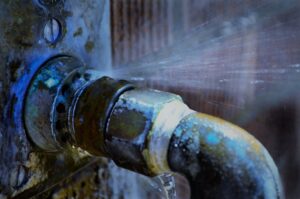
Every winter, thousands of homeowners throughout the Northeast experience the wrath of water damage inside their homes caused by ice and freezing temperatures. According to a local home expert, now is the time to prevent a “flood” of problems.
“Burst pipes are the most common culprit of home water leaks in the winter,” said Laura Champagne, co-founder of Connecticut-based Natural Home Solutions LLC, a mold remediation company serving the Northeast region. “When the water in the pipe freezes, it expands and ruptures.”
Steps to ward off water damage in the home from a burst pipe include these suggestions:
- Install pipe insulation made of foam or fiberglass on all pipes, particularly those in unheated spaces, such as attics and crawl spaces.
- Shut off the water to outside faucets. Add extra protection with an insulated spigot cover.
- Disconnect any exterior lines like garden hoses.
- Shut off water to appliances if going out of town.
- Install water sensors that alert home or business owners quickly in the event of a water leak.
- Maintain an average home temperature of 68 degrees.
“Pipes with running water increase the risk of potential damage, because when the water becomes frozen within a pipe, there is the possibility that it will burst,” Champagne added. “However, when the source is cut off, the water that is trapped inside will drain out.”
Additionally, check the water heater for any faulty pipes, unusual noises and leaks, or schedule maintenance to drain sediment. Since the temperature of the cold water drops about 25 degrees during the winter, water heaters have to work harder to heat up. When an aged heater is constantly running and working extra hard, it’s only a matter of time before it starts to leak or worse burst.
Preventive steps need to be taken outside the home as well. Champagne said that ice dams are formed from melting snow and water that run down the roof and freeze along the roof line into the gutter. This then causes water to back up and go under the roof shingles, allowing water to leak into the home.
“Use a snow removal rake after it snows to safely get the snow off your roof as soon as possible, or install heated roof coils,” she said. “When the snow accumulated around the perimeter of your house begins to melt, it can seep far down into the soil and leak through your basement walls. To prevent this, look out for any cracks in your basement and seal them now. Be sure to shovel away any snow throughout the winter.”
Champagne warned that beyond soaking the carpets and furniture, mold will quickly take hold after any water leak. If left untreated, a thriving mold colony can rot wooden flooring, damage drywall, generate cosmetic and structural damage and ruin interior furnishings – not to mention cause sickness. (Sofas are the number one source of mold in the home.)
“As people travel throughout the day, their clothing picks up mold spores and then they unknowingly deposit them on their couch, which will then breed and cause a quick infestation when becoming wet or moist,” she said.
“At the first sign of water, immediately engage a remediation company to fix the damaged area and dry out any moisture,” said Jim Oliver, Champagne’s business partner. “Your insurance adviser should be consulted to determine if it makes sense to submit a formal claim and make sure you are taking the necessary steps post-loss.
“Drying out a water-damaged home in cold weather is a challenge,” he added. “If you require mold remediation, we eliminate contaminants with EnzyCleanse, an effective organic solution that is nontoxic and safe around humans or pets. We also perform optional services such as encapsulation, HEPA vacuuming and air scrubbing.”
That, however, is just the beginning: “It’s often not enough to just replace drywall, flooring and roofing,” he said. “Air quality needs to be monitored to ensure that the home is truly restored and healthy for those who live there.”
For more, visit naturalhome.solutions.






















